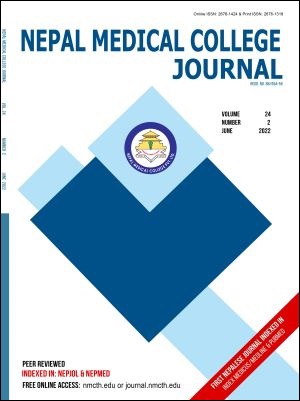Role of colour Doppler ultrasonography in the evaluation of deep vein thrombosis of peripheral limbs at a tertiary care centre in Kathmandu
DOI:
https://doi.org/10.3126/nmcj.v24i2.46046Keywords:
Lower extremity, ultrasonography, venous thrombosisAbstract
Deep venous thrombosis is the development of blood clots in the deep veins. The management of deep venous thrombosis has been irreversibly altered after the introduction of Doppler ultrasound. This study aims to find out the prevalence of deep vein thrombosis of lower limbs diagnosed with colour Doppler ultrasonography at a tertiary care centre. A descriptive cross-sectional study was conducted in the Department of Radiology at a tertiary care hospital from October, 2021 to March, 2022. The study was conducted among 100 patients with clinically suspected deep venous thrombosis. Data were entered and analyzed using Microsoft Excel. Point estimate at 95.0% confidence limits was calculated and results were expressed in frequency and proportion for binary data. Among 100 patients, deep venous thrombosis was diagnosed in 88 (88.0%) patients (95% CL: 81.63-94.37). The patients had a mean age of 48.4±1.6 years. Out of 88 patients, 46 (52.3%) were male and 42 (47.7%) were female. Seventy-three (82.9%) patients had acute DVT. Multiple contiguous veins were predominantly involved (75.0%) than isolated veins (25.0%). Coexisting pathological conditions were seen in 41 cases (46.6%). The prevalence of deep vein thrombosis of lower limbs diagnosed with colour Doppler ultrasonography was higher when compared to other similar reported literatures.
Downloads
Downloads
Published
How to Cite
Issue
Section
License
Copyright (c) 2022 Nepal Medical College Journal

This work is licensed under a Creative Commons Attribution 4.0 International License.
This license enables reusers to distribute, remix, adapt, and build upon the material in any medium or format, so long as attribution is given to the creator. The license allows for commercial use.




